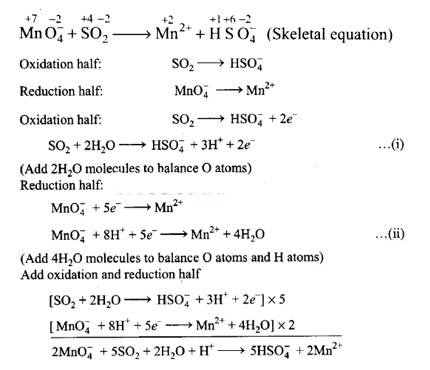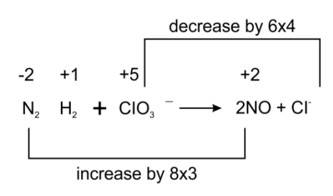Chemistry NCERT Exemplar Solutions Class 11th Chapter Eight
Get insights from 125 questions on Chemistry NCERT Exemplar Solutions Class 11th Chapter Eight, answered by students, alumni, and experts. You may also ask and answer any question you like about Chemistry NCERT Exemplar Solutions Class 11th Chapter Eight
Follow Ask QuestionQuestions
Discussions
Active Users
Followers
New answer posted
5 months agoContributor-Level 10
(a) let x= oxidation number of sulphur, and +1 is oxidation number of Na, -2 is oxidation number of O, also we can assume total charge on compound = 0 then solving we get.
+2 + 2x - 6 = 0
x = +2.
(b) let x= oxidation number of sulphur, and +1 is oxidation number of Na, -2 is oxidation number of O, also we can assume total charge on compound = 0 then solving we get.
+2 + x - 6 = 0
x = +4
(c) let x= oxidation number of sulphur, and +1 is oxidation number of Na, -2 is oxidation number of O, also we can assume
New answer posted
5 months agoContributor-Level 10
This is a Short answer type question as classified in NCERT Exemplar
(i) Let the oxidation number of P in HPO32- be x.
Therefore, +1 + x + (-6) = -2
x = +3
Oxidation number of phosphorus is= +3.
(ii) Let the oxidation number of P in PO43- be x.
Therefore, x + (-8) = -3
x = +5
Oxidation number of phosphorus is= +5.
New answer posted
5 months agoContributor-Level 10
We can balance the given reaction by ion electron method as
Cl2O7 (g) + H2O2 (aq) → ClO2- +O2 (acidic medium)
This is a Short answer type question as classified in NCERT Exemplar
Balancing bu ion electron method
2 * { Cl2O7 + 6H+ + 8e- → 2ClO2- + 3H2O
8 * { H2O2 → O2 + 2H+ + 2e-
The balanced chemical is given as-
2Cl2O7 + 12H+ + 16e- → 4ClO2- + 6H2O
8H2O2 → 8O2 + 16H+ + 16e-
2Cl2O7 + 8H2O2 → 4ClO2- + 6H2O + 8O2 + 4
New answer posted
5 months agoContributor-Level 10
This is a Short answer type question as classified in NCERT Exemplar
(i) 2Mn0–4 + 5S02 + 2H20 + H+?5HS0–4 + 2Mn2+
Balancing by ion-electron method:

(ii) We can balance the given reaction by oxidation number method-
Balancing by oxidation number method as to make the electron gain and loss equal as given
3N2H4 + 4ClO3- → 6NO + 4Cl- + 6H2O
The balanced chemical is given as-

(iii) We can balance the given reaction by ion electron method as
Cl2O7(g) + H2O2 (aq) → ClO2- +O2 (acidic medium)
Balancing bu ion electron method
2 * { Cl2O7 + 6H+ + 8e- → 2ClO2- + 3H2O
8 * { H2O2 → O2 + 2H+ + 2e-
The balanced chemical is
New answer posted
5 months agoNitric acid is an oxidising agent and reacts with PbO but it does not react with PbO2 . Explain why?
Contributor-Level 10
This is a Short answer type question as classified in NCERT Exemplar
Since nitric acid itself is an oxidising agent therefore, it is unlikely that the reaction may occur between PbO2 and nitric acid. However, the acid-base reaction occurs between PbO and nitric acid because PbO is a basic oxide.
New answer posted
5 months agoContributor-Level 10
This is a Short answer type question as classified in NCERT Exemplar
The given compound can differ in reactivity as-Lead is present in +4 oxidation state, whereas the stable oxidation state of lead in PbO is +2. PbO2 thus, can act as an oxidant (oxidising agent) and, therefore, can oxidise chloride ions of HCl into chlorine.
New answer posted
5 months agoContributor-Level 10
This is a short answer type question as classified in NCERT Exemplar
In MnO42–, Mn is in the highest oxidation state that is +7 hence here manganese cannot undergo oxidation that is why disproportionate is not possible whereas in MnO42- manganese is in +6 oxidation state which can be oxidized as well as reduced.
New answer posted
5 months agoContributor-Level 10
This is a Short answer type question as classified in NCERT Exemplar
The given reaction is as below-
Cl2 (g) +2OH-- (aq)→ClO-- (aq)+ Cl-- (aq) + H2O (l)
In the given reaction, oxidation number of Cl increases from 0 (in Cl2) to +1 (in ClO-) and decreases to -1 (in Cl-). Therefore, Cl2 is both oxidized to ClO- and reduced to Cl-. Since Cl- ion cannot act as an oxidizing agent (because it cannot decrease its O.N. lower than -1), hence, Cl2 bleaches substances due to oxidizing action of hypochlorite, ClO ion.
New answer posted
5 months agoContributor-Level 10
This is a Long answer type question as classified in NCERT Exemplar
We can Measure the electrode potential of the given species by connecting the redox couple of the given species with standard hydrogen electrode. If it is positive, the electrode of the given species acts as reductant and if it is negative, it acts as an oxidant. Find the electrode potentials of the other given species in the same way, compare the values and determine their comparative strength as an reductant or oxidant. Example Measurement of standard electrode potential of electrode E? Zn2+/Zn using SHE as a reference electrode.
Types of Redox Reactions
The diffe
Taking an Exam? Selecting a College?
Get authentic answers from experts, students and alumni that you won't find anywhere else
Sign Up on ShikshaOn Shiksha, get access to
- 65k Colleges
- 1.2k Exams
- 679k Reviews
- 1800k Answers
